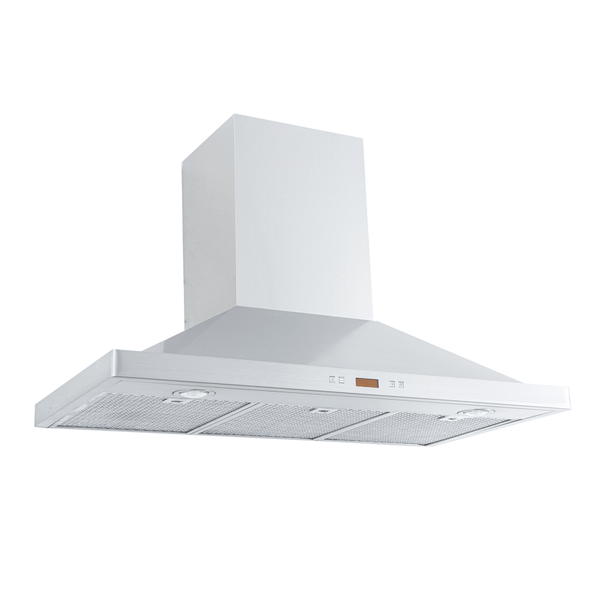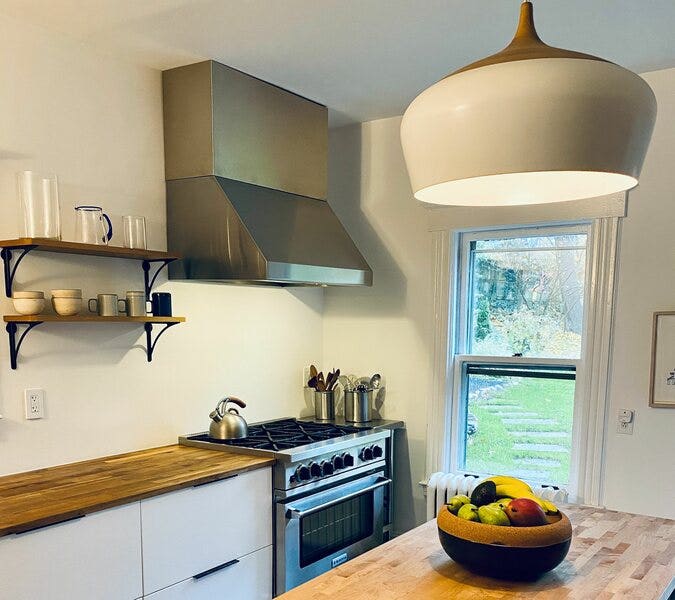Are you getting ready to install your range hood? One of the most important steps in the process is installing your ductwork. Choosing the right material for your duct is essential to maximize the efficiency of your hood.
There are two popular types of ducting, flex and semi-rigid or rigid. You might be wondering: can I use flex duct for my range hood?
No, do not use flex duct for your range hood. Most flex duct is made of cheap materials and will not last nearly as long as semi-rigid or rigid duct. You run the risk of having to clean or replace your duct which is quite expensive.
Can I use 4-inch duct for a range hood?
Yes, but duct size depends on the CFM of your range hood. Four-inch duct is too small for most range hoods. It is only appropriate for hoods that are rated 400 CFM or under.
We recommend a minimum duct size of 6” for 600 CFM hoods, 8” for 900 CFM hoods, and 10” for 1200 CFM range hoods. Take a look at the graphic below for more information, or check out our full article on range hood duct sizing here.
What is the minimum duct size for a range hood?

The minimum duct size for a range hood is 4”. This duct size is appropriate for low-CFM hoods from big box stores. Most range hoods will require between 6” and 8” duct, while more powerful outdoor or professional range hoods may require 10” duct or larger.
Can a range hood vent have bends?
Your range hood vent should have no more than two bends in the duct run. Each 90º bend significantly increases the air resistance in your duct system. This makes it harder for all your cooking exhaust to reach the outside of your home.
If you have too many bends, the greasy air will build up inside your duct, reducing the efficiency of your vent hood.
Does duct length affect CFM?
The longer your duct, the more CFM you’ll want to ensure all your cooking exhaust makes it to the outside. Typically, your duct should not be longer than 30’ to maximize efficiency. Unless your setup is a rare case (several elbows, longer than 30, upward run, etc.), you won’t have to change your CFM based on the length of your duct.
Which is better: flex duct or metal?
Metal duct is much more durable than flex duct. You should always prefer metal duct over flex duct because of its longevity.
Can ductwork be too big?
It’s not a major issue if your ductwork is larger than necessary. But a problem arises when you install a smaller duct. The duct will choke the greasy air, reducing the efficiency of your range hood.
What is the max recommended length of flex duct?
The max recommended length of flex duct is about 20’. Metal duct systems can run about 30’ but because flex ducts are less durable, you’ll want a shorter duct run. Always install metal duct if you have the option. You will get more out of your range hood in the long run.
What type of duct is best for venting a range hood?
Rigid duct is the best type of duct to vent your range hood. It requires a one-time installation and little to no maintenance as long as you clean your range hood filters. Most rigid ductwork is made from durable stainless steel.
A range hood should last you 10+ years with minimal repairs or issues. Occasionally a light will burn out or a control panel may stop working, but ductwork, as long as it’s rigid, will remain intact. Otherwise, you will likely run into problems within a year or even a few months. Even if you seldomly cook, the safe, cost-effective bet is to go with rigid ductwork.
Is it OK to vent my range hood into the attic?
No, if you vent your hood into the attic, the buildup of dirt and chemicals can be dangerous to your health and harmful to your home as well. It's imperative that you vent your hood to the exterior of your home, not into the attic, inside walls, or between floors.
Where do you vent a range hood?
You can vent a range hood through your wall horizontally or through your ceiling. Wall mount range hoods and under cabinet range hoods can be vented horizontally or vertically, while island hoods can only be vented vertically.
There is no ‘best way’ to vent your range hood, but you want to make sure that you have enough space behind your walls to run the ductwork before proceeding with the installation. Further, it is best practice to reduce the number of elbows in your ductwork. This maximizes the efficiency of airflow, creating a path of least resistance.
Your ductwork should have no more than three elbows. Further, make sure that you allow 18” of space between elbows to keep the amount of resistance manageable. Otherwise, you’ll experience back-drafting, where air pulled into your hood falls back into your kitchen – this is never ideal!
What is the purpose of a transition duct for a range hood?
A transition duct for a range hood allows you to increase or reduce the size of your duct. For example, if you have an existing 4” duct, you can use a duct transition to increase its size to 6”. Duct transitions are important because duct that’s too small reduces the efficiency of your hood.
Some transitions are duct reducers. For example, your duct would decrease from 10” to 8”. These aren’t necessary, though.
It’s more important to ensure you use an appropriately sized duct. Don’t use a duct smaller than our minimum requirements outlined above!
Here are a couple of examples of duct reducers compared. With the right-sized duct, you’ll maintain laminar flow, or the smooth flow of air through your duct. Learn more about laminar flow in this complete article.

Take a look at this chart once again for minimum duct sizes for your range hood.

We hope these answers to common questions about range hood ducting were helpful for you. Remember to avoid using flex duct if possible. Metal duct will always be the better option.
Also, always hire a professional contractor or HVAC expert to install your ductwork. A well-done installation will be worth it in the long run, as you won’t have to worry about your range hood duct at all. It will allow the range hood as a whole to run more efficiently.
Remember to keep your filters in top shape too, which will drastically reduce the risk of future issues with your blower or ductwork.
If you have any questions about ductwork, duct size, or anything else range hood related, call our customer support team at (877) 901-5530. Thanks for reading!












